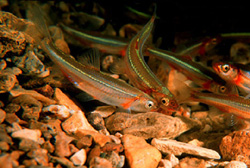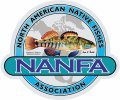| About NANFA |
| Home |
| Mission |
| Publication |
| Grant Programs |
| Administrivia |
| Join NANFA |
| Activities & Programs |
| Annual Convention |
| Regional Outreach |
| Breeder Awards Program |
| E-mail List Archive |
| FishMap.org |
| On-line Discussion Forum |
| Member Photo Gallery |
| For Sale |
| American Currents PDFs |
| Wisconsin's Fishes AC |
| HIDDEN RIVERS Snorkel Guide |
| NANFA Logo T-Shirts |
| Convention T-Shirts |
| Biology & Captive Care |
| Species Checklist |
| Conservation |
| Collecting |
| Fishwatching |
| Captive Care |
| Learning More |
| Fish in Focus |
| Web Links |
| Books & Journals |
Introducing the NANFA Breeder's Award Program (BAP)
|
Do you wish to submit a report? |
 Rosyface shiner, Notropis rubellus
Rosyface shiner, Notropis rubellus© Garold W. Sneegas |
Objectives
- To recognize outstanding achievement in the breeding and rearing of North American fishes by NANFA members.
- To provide the opportunity for breeders to contribute to a library of information on native fishes. This library will be available to others with an interest in the natural history and captive husbandry of North American fishes.
Awards
Certificates will be awarded annually at the convention to those members who have submitted enough forms to qualify for one of the awards listed below. Any members who do not attend the convention, but have earned an award, will receive them in the mail following the convention. Members of the award committee will not review their own reports.
Award |
Points |
| Breeders Award | 50 points |
| Advanced Breeders Award | 200 points |
| Expert Breeders Award | 400 points |
| Master Breeders Award | 600 points |
Specialty Awards
Specialty Awards can be earned by breeders who work extensively with one particular family or group of fishes. All points for fishes in one family must add up to the minimum point value listed below, and any other requirement must be met, such as earning points from more than one genus within the family. Following are the awards currently offered. Additional awards may be created if there is sufficient interest by breeders.
Award |
Points |
Requirements |
| Centrarchidae Award | 600 points |
2 genera |
| Cyprinidae Award | 600 points |
5 genera |
| Killifish/Topminnow Award | 600 points |
2 genera |
| Catfish Award | 600 points |
any species |
| Percidae Award | 600 points |
2 genera |
Requirements for earning points
There are five ways to earn points for each fish species. The breeder can earn the full point value of a species in each of the first four categories below, and twice the full point value of a species in the fifth. The final score will be the number of the first four categories fulfilled, multiplied by the point value of the species bred, plus twice the point value of the species, if category five is fulfilled.
Following are the five categories in which the point value of each species can be earned, cumulatively.
Category |
Points |
|
Regular Point Value |
|
Regular Point Value |
|
Regular Point Value |
|
Regular Point Value for each generation |
|
Twice the Point Value |
To earn points in categories 1-4, the breeder must fill out a BAP Report Form with all required information and return it to the NANFA BAP Committee.
Example: If bluegill is a 10 pt fish, the breeder can earn at least 60 points
Accomplishment |
Point Value |
Total Points |
| Breed wild conditioned bluegills | 10 |
10 |
| Breed bluegills that were kept in captivity through one spawning season | 10 |
20 |
| Raise captive spawned bluegill fry (60 days) | 10 |
30 |
| Raise and breed captive spawned bluegill fry | 10 |
40 |
| Submit 400+ Spawning Report | 20 |
60 |
Additional point values can be earned as successive generations of bluegill are bred from the same captive stock.
Note: Since one of BAP's objectives is to share information about the reproductive biology and captive propagation of native fishes, all participants are strongly encouraged to submit a Spawning Report. Shorter write-ups will be accepted, but 400 words are required to receive the additional points. Spawning Reports may be published in American Currents at the editor’s discretion.
Fish Point List
The Fish Point List will be updated by the NANFA BAP Committee at least every decade or as needed. Fishes that are found to be particularly easy or difficult to breed may be assigned to new point categories. Existing scores will not be changed to reflect these reassignments, so point holders will not gain or lose points as a result of these changes. The original point values can be earned up to one year after a point value has been lowered by persons already working with a particular species. During the first few years of the program the point values will be updated yearly.
The species that will be considered as North American fishes, for the purposes of this program, are those that are listed as such on the NANFA Checklist of Freshwater Fishes of North America. This site can be reached at :
http://nanfa.org/checklist.shtml
This official list may be amended at the discretion of the NANFA BAP Committee.
If a spawning report is received for a North American fish family that is not on the list, the BAP Committee will assign points within three months of receipt of the Report Form. That species/family will then be added to the point value list.
|
5 Point Fish Poeciliidae - gambusia, mollies, etc. Goodeidae - All livebearing species 10 Point Fish 15 point fish 20 point fish 25 point fish |
Note on Marine Species
The NANFA Checklist only covers fishes that are restricted to or enter fresh waters. Because there is limited information on the captive breeding of most marine species, we have not listed the vast majority of them here. We will, however, accept and encourage submission of Report Form and Spawning Reports on marine fishes native to North America. Point values will be assigned as reports are received.
Note on Unrecorded Species
Be the first in the program to spawn and document the event and you will likely get a higher point value for that species than will future reports. As an incentive for breeders to work with little known species, the first spawning report submitted for any species which has not been previously reported to the NANFA BAP Committee will receive a point value one step higher than its listed point value. Once an initial report in submitted for a species, the BAP Committee will evaluate the report and determine whether the species is difficult to spawn or relatively easy, and assign the species an appropriate value for later reports. A list of species previously reported to the program will be maintained for breeders' reference.
Additional rules
Using hormones to induce spawning is prohibited.
Anyone working with endangered/protected fishes will need documentation showing they are allowed to be working with these species.
Submit a Breeder Awards Program Report
 Orangespot sunfish,
Orangespot sunfish,Lepomis humilis |
Are you ready to participate? Great -- we're looking forward to hearing from you! Follow this link to the Official NANFA Breeder's Award Program Report Form PDF |
